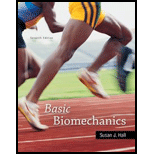
Basic Biomechanics
7th Edition
ISBN: 9780073522760
Author: Susan J Hall
Publisher: McGraw-Hill Education
expand_more
expand_more
format_list_bulleted
Concept explainers
Question
Chapter 5, Problem 8AP
Summary Introduction
To explain: The sports in which the athletes are more likely to incur injuries related to insufficient joint stability.
Concept introduction: The musculoskeletal system of the body is composed of skeleton (bones and joint) and the soft tissues (skeletal muscles, ligaments and tendons). The attachment site of two or more bones is known as a joint or an articulation. The function of the joints is to provide stability and mobility to the skeleton. Joint stability is the ability of a joint to resist dislocation of the articulated bones.
Expert Solution & Answer
Want to see the full answer?
Check out a sample textbook solution
Chapter 5 Solutions
Basic Biomechanics
Ch. 5 - Prob. 1IPCh. 5 - Describe the directions and approximate ranges of...Ch. 5 - Prob. 3IPCh. 5 - Prob. 4IPCh. 5 - What factors contribute to flexibility?Ch. 5 - Prob. 6IPCh. 5 - How is flexibility related to the likelihood of...Ch. 5 - Prob. 8IPCh. 5 - Explain why grip strength diminishes as the wrist...Ch. 5 - Why is ballistic stretching contraindicated?
Ch. 5 - Prob. 1APCh. 5 - How is articular cartilage similar to and...Ch. 5 - Prob. 4APCh. 5 - Discuss the relative importance of joint stability...Ch. 5 - What specific exercises would you recommend for...Ch. 5 - What specific exercises would you recommend for...Ch. 5 - Prob. 8APCh. 5 - Prob. 9APCh. 5 - What exercises would you recommend for senior...
Knowledge Booster
Learn more about
Need a deep-dive on the concept behind this application? Look no further. Learn more about this topic, bioengineering and related others by exploring similar questions and additional content below.Similar questions
- The medical term for the form of arthritis that is commonly known as wear-and-tear arthritis is ___________________. osteoarthritis Rheumatoid arthritisarrow_forwardWatch this animation (http://openstaxcollege.org/l/hipreplace) to observe hip replacement surgery (total hip arthroplasty), which can be used to alleviate the pain and loss of joint mobility associated with osteoarthritis of the hip joint. What is the most common cause of hip disability?arrow_forwardA chronic bone disease that is characterized by the abnormal breakdown of bone followed by abnormal bone formation is known as ____________. osteomalacia Pagets diseasearrow_forward
- An abnormal increase in the forward curvature of the lumbar spine is known as ________ kyphosis lordosis scoliosis spondylosisarrow_forwardWhat is a joint?arrow_forwardWatch this video (http://openstaxcollege.org/l/flexext) to learn more about the flexion and extension of the knee, as the femur both rolls and glides on the tibia to maintain stable contact between the bones in all knee positions. The patella glides along a groove on the anterior side of the distal femur. The collateral ligaments on the sides of the knee become tight in the fully extended position to help stabilize the knee. The posterior cruciate ligament supports the knee when flexed and the anterior cruciate ligament becomes tight when the knee comes into full extension to resist hyperextension. What are the ligaments that support the knee joint?arrow_forward
- The specialized soft-tissue manipulation technique used to ease the pain of conditions such as fibromyalgia, movement restrictions, and temporomandibular joint disorders is known as ____________________________ myofascial release occupational therapy RICE therapeutic ultrasoundarrow_forwardA meniscus is ________. a fibrocartilage pad that provides padding between bones a fluid-filled space that prevents friction between a muscle tendon and underlying bone the articular caililage that covers the ends of a bone at a synovial joint the lubricating fluid within a synovial jointarrow_forwardDescribe the two types of cartilaginous joints and give examples of each.arrow_forward
arrow_back_ios
arrow_forward_ios
Recommended textbooks for you
 Medical Terminology for Health Professions, Spira...Health & NutritionISBN:9781305634350Author:Ann Ehrlich, Carol L. Schroeder, Laura Ehrlich, Katrina A. SchroederPublisher:Cengage Learning
Medical Terminology for Health Professions, Spira...Health & NutritionISBN:9781305634350Author:Ann Ehrlich, Carol L. Schroeder, Laura Ehrlich, Katrina A. SchroederPublisher:Cengage Learning Biology 2eBiologyISBN:9781947172517Author:Matthew Douglas, Jung Choi, Mary Ann ClarkPublisher:OpenStax
Biology 2eBiologyISBN:9781947172517Author:Matthew Douglas, Jung Choi, Mary Ann ClarkPublisher:OpenStax Comprehensive Medical Assisting: Administrative a...NursingISBN:9781305964792Author:Wilburta Q. Lindh, Carol D. Tamparo, Barbara M. Dahl, Julie Morris, Cindy CorreaPublisher:Cengage LearningBasic Clinical Lab Competencies for Respiratory C...NursingISBN:9781285244662Author:WhitePublisher:Cengage
Comprehensive Medical Assisting: Administrative a...NursingISBN:9781305964792Author:Wilburta Q. Lindh, Carol D. Tamparo, Barbara M. Dahl, Julie Morris, Cindy CorreaPublisher:Cengage LearningBasic Clinical Lab Competencies for Respiratory C...NursingISBN:9781285244662Author:WhitePublisher:Cengage

Medical Terminology for Health Professions, Spira...
Health & Nutrition
ISBN:9781305634350
Author:Ann Ehrlich, Carol L. Schroeder, Laura Ehrlich, Katrina A. Schroeder
Publisher:Cengage Learning



Biology 2e
Biology
ISBN:9781947172517
Author:Matthew Douglas, Jung Choi, Mary Ann Clark
Publisher:OpenStax

Comprehensive Medical Assisting: Administrative a...
Nursing
ISBN:9781305964792
Author:Wilburta Q. Lindh, Carol D. Tamparo, Barbara M. Dahl, Julie Morris, Cindy Correa
Publisher:Cengage Learning

Basic Clinical Lab Competencies for Respiratory C...
Nursing
ISBN:9781285244662
Author:White
Publisher:Cengage